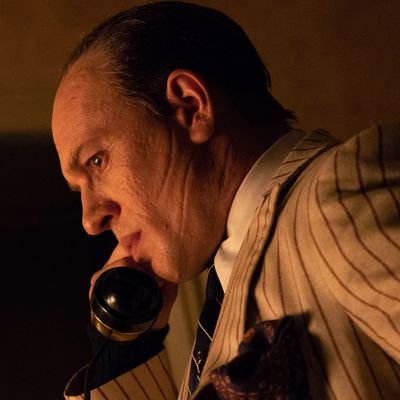
Tom Hardy approaches the title role in Capone the way a champion competitive eater might the deciding pie — flopping in face first and messily devouring everything until he’s left rooting around for the last few crumbs in an empty container. Hardy is a great actor with some exquisitely weird impulses, drawn more to the grotesque aspects of characters than the grand ones. He’s capable of holding the screen while appearing as just a worried set of eyes above an oxygen mask in Dunkirk, or while driving alone down a motorway at night for an hour and a half in Locke. But there’s a kind of physicality-first role he obviously relishes — the kind that enables him to treat Venom like slapstick buddy comedy and play a burly MMA fighter as a near-wordless embodiment of grief and rage in Warrior. His take on Al Capone might just be the most maximalist of those maximalist performances, so rooted in guttural outbursts and bodily expulsions that it’d threaten to overwhelm the overall vision of any movie — presuming the movie had one.
Capone does seem to have something on its mind, even if that something is rejecting the biopic tendency to psychologically solve its subject. The film is the third from Josh Trank, a director whose Hollywood rise and fall unfolded with comedic efficiency. He made his debut, at the age of 26, with the 2012 found-footage superhero flick Chronicle, a hit that netted him gigs directing a stand-alone Star Wars installment and a reboot of Fantastic Four. But the shoot for the latter was a disaster, and Trank either quit or was fired from the Star Wars project a few months before Fantastic Four bombed in theaters in August 2015. Capone, which was produced independently, represents not just a potential comeback vehicle for Trank, but his bid for artistic redemption — something personal, truer to his vision, and unencumbered by studio interference. There’s no question that Trank finds resonance in the idea of the legendary gangster staggering around a Miami Beach mansion in the grip of dementia. But he can’t convey that profundity to an audience. The problem with Capone isn’t that it’s an unconventional biography or a challenge to the image of a famous figure. It’s that it’s not bold enough on either of those fronts.
Al, who’s referred to almost exclusively as “Fonz” by the other characters, is in the final year of his life when the film starts, having been released from prison, judged no longer a danger due to the ravages of his neurosyphilis. He shares the palatial grounds of his Florida estate with his wife, Mae (Linda Cardellini), various goons and gardeners, and a set of statues that are being sold off to pay for bills. There’s also a constant flow of visitors, like the couple’s son (Noel Fisher), and a physician (Kyle MacLachlan), and an old friend (Matt Dillon), and an FBI agent (Jack Lowden). Some of these guests are hoping to find out if Al still has money stashed away, some are informants, and some, regrettably, reveal themselves to be ghosts. They all haunt Al equally, as his sense of reality grows shaky, and he has hallucinatory visions of the past that are the film’s most vibrant interludes. It’s hard to blame him for wanting to drift away from his body, whose failures are highlighted by hacking coughs and bursts of incontinence. After a second stroke, the omnipresent cigar he’s always smoking gets replaced by a carrot on his doctor’s orders. “What is he, fucking Bugs Bunny?” a family member howls in protest.
No — he’s more like a big, dangerous baby, still capable of lashing out even when staggering around in diapers. He’s the iconic gangster stripped of dignity and glamour and exposed as pathetic, an image that would feel more revelatory if it weren’t at the heart of so many major mob portrayals over the last few decades. Capone runs this idea into the ground, showing Al shoving spaghetti into his maw like a toddler, doing some paranoid howling at surveillance that may or may not be imagined, and shitting his pants twice. The only thing that makes the monotony tolerable is Hardy’s go-for-broke performance, which isn’t effective, but is mesmerizing. There’s just so much to it, from the liver-spotted, thinning-haired, rheumy-eyed old-age makeup to the voice (the voice!), which is wheezed out in a Gollum-esque croak. Hardy grunts and growls more than he speaks, practically percussive in his communication. When he does speak, it’s frequently mush-mouthed and not infrequently in Italian, and boy, does he relish those opportunities — hissing “Let’s go fishing” in the language as though delivering a diabolic incantation. He sings along to The Wizard of Oz. He shoots an alligator. He’s so obviously enjoying himself that there’s a gratification in watching him even when the performance feels more like performance art. And while that might not be the kind of emotional payoff Trank was aiming for with the film, it is, nevertheless, a memorable spectacle — the actor turned loose to eat the world, with no one daring to hold him back.
*A version of this article appears in the May 25, 2020, issue of New York Magazine. Subscribe Now!
More Movie Reviews
- The Thriller Drop Is a Perfect Addition to the Bad-First-Date Canon
- The Accountant 2 Can Not Be Taken Seriously
- Another Simple Favor Is So Fun, Until It Gets So Dumb


